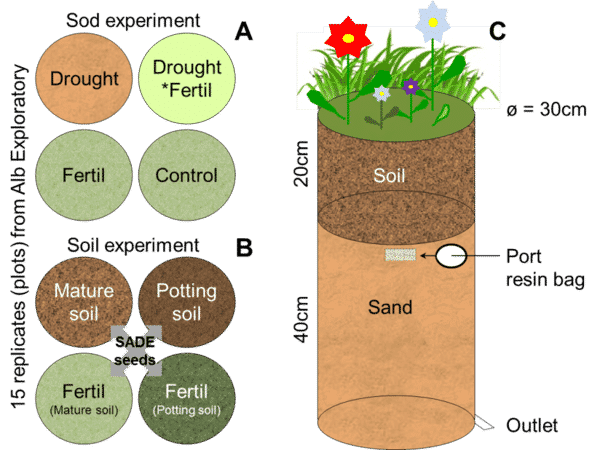Effects of disturbance and seeding on composition and ecosystem functions of plant communities

Biodiversity experiments have often shown positive relationships between plant species numbers and various ecosystem functions such as productivity, biomass quality, nutrient cycling, stability and resistance to disturbances and invasions. Nevertheless, there is a scientific debate on whether the results of these rather controlled experiments can be transferred to real ecosystems. In our project, the effects of land use intensity, pre-disturbance diversity, soil seed bank and seeding on the resilience of ecosystem functions after a disturbance event are investigated. The focus is particularly on the role of the permanent seed bank as part of the invisible diversity as well as the effects of additionally introduced seeds from regional seeds on plant communities and ecosystem functions.
Within the full factorial disturbance seeding experiment SADE, we will explore how the targeted introduction of plant species influences the regeneration of vegetation and its essential ecosystem functions after a severe disturbance. This will be done along a real diversity and land use gradient. Special attention is also paid to the resilience of the plant community and important productivity-related ecosystem functions. In a complementary mesocosm experiment, we will test whether and how plant diversity modifies effects of experimental fertilisation and drought on, for example, nutrient cycling. We will test the following hypotheses:
- In disturbed areas, subordinate and transient species emerging from the diaspora bank will play an important role in maintaining numerous ecosystem functions, especially at the beginning of revegetation.
- In species-rich stands, plant diversity and many ecosystem functions will be restored more quickly without seeding than in stands with low diversity, as regeneration in these stands is severely limited by a lack of diaspores.
- Species enrichment through seeding with Regio seed will positively influence various ecosystem functions such as yield, forage quality, desiccation resistance and nutrient uptake.
- High plant diversity will positively influence nutrient retention and reduce losses of nutrients to groundwater or deeper soil layer
Our project will explore the diaspora bank on all 75 plots of the SADE experiment in all three study areas to investigate the relevance of plant diversity for the recovery of the vegetation community after the disturbance event. The main indicators for maintaining ecosystem functions are productivity, nutrient storage in the vegetation, and abundances of stable isotopes of nitrogen (N) and carbon (C) as integrative measures of N cycling and drought stress. In addition, mineralisation rates of N and phosphorus (P) in the soil are measured on all plots using exchange resins (so-called resin bags) to record nutrient availability and surplus in relation to the diversity and land use intensity gradient. Interactions between plant diversity, drought stress and fertilisation on nutrient cycling will be investigated in a separate ex-situ mesocosm experiment with the aim of isolating controlling factors and identifying key mechanisms.














